Introduction to Sphagnum
Sphagnum is commonly referred to as peat moss, bog turf moss or moss moss due of its ecological significance in the creation of peat and bog. These plants are perennial and thrive in swamps and damp habitats such as rocky slopes, where water accumulates , or in areas where it drips.
They develop along the banks of lakes. They gradually take to the water in bogs that creep and, eventually, they completely cover the lake, transforming it into an agro-bog. Thus, Sphagnum is also known as Bog the moss.
Then, angiosperms begin to invade the bog. In the process, the surface of the bog is changed and the water of bogs turns extremely acidic. In this soil that is acidic, the upper part of the Sphagnum gametophores will continue to grow, while the lower portion will die slowly. The plant parts that are dead cannot be decomposed easily in soil that is acidic.
In a different way the acidic medium aids to stop the proliferation of fungi bacteria, and other pathogenic microorganisms. It also slows down the process of decay of the dead material.
Thus, a huge amount of dead remains accumulates each year, which is then compressed by plants above, so the compact, dark-colored substance, rich in carbon, is created, which is referred to as peat. Since Sphagnum is the main component of peat, it’s often known as peat moss.
Habit and Habitat of Sphagnum
Sphagnum is represented by around 336 species, all of which are cosmopolitan and distributed. In India it is represented by 20 species of the Himalayas. They are either semiaquatic or aquatic and develop in thick masses or in cushions in ponds, swamps and lake margins, humid heaths, and wet hill sides.
Characteristics of Sphagnum
- The absence of rhizoids is evident in adults gametophore leaves.
- Branch tufts emerge from the axil of each fourth leaf.
- There is no mid rib present on the leaves.
- Stems and leaves have distinctive patterns and structures. Cortex in the stem of old is soft and may develop spiral thickenings. Single-layered leaves are composed of two kinds of cells including large hyaline cell and tiny green photosynthetic cells.
- The presence of hyaline retort cell.
- The water that it is growing in is extremely acidic. It’s due to the presence an organic substance that is colloidal within the cell wall.
Structure of Sphagnum
A. External Features:
The gametophyte stage of Sphagnum can be seen in two distinct stages: (a) protonema in juvenile form as well as (b) mature gametophore or leafy stage. The mature plants form massive clumps. Their shoots are either whitish, or brownish green.
Each species of Sphagnum is able to accumulate water and usually develops with vivid colors (deep red or rose pink.) because of being able to absorb water-soluble colors like anthocyanin. They are perennial and show unlimited growth due to the Apical cell that has three cutting edges.
Young gametophytes have multicellular rhizoids that have an the oblique septa. Mature gametophytes, however, do not bear rhizoids. They are distinguished into an upright branched axis as well as leaves.
Main Axis and Branches
The main Axis is weak and weak in the beginning however it becomes straight and strong at the time of the time of maturity. The main axis is more long for aquatic animals, and is quite short in terrestrial species because of the gradual death of the basal portion that is older.
The axis has numerous branches on the lateral side. A single branches or in tufts of three to eight branches emerge from the axils of each fourth leaf on the main axis. Near the apex on this main stem a number of tiny branches with limited development are densely packed into the head of coma, which is compact.
The coma forms at the apex of the stem due to the constricted growth of the apical internodes. As the stem expands in length , these branches expand and then turn into normal branches.
Submerged species (S. Obesum, S. cuspidatum) have the same branches in structure and form however, terrestrial species produce two kinds of branches., (i) pendent branches as well as (ii) ascending divergent branch.
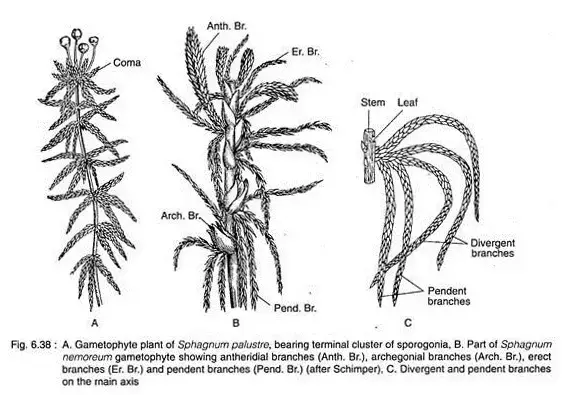
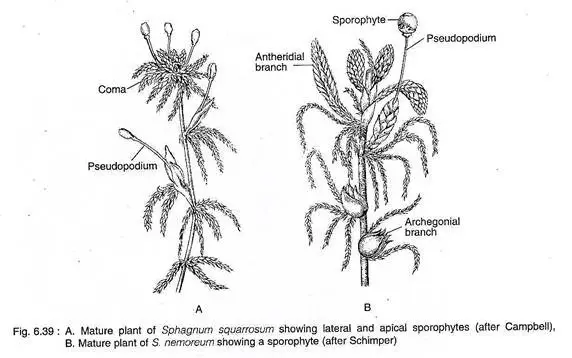
Pendent Branches
These are long slender , loosely placed, then they turn to the left and then expand along the main axis. They are also known as de-current or flagelliform branches.
Divergent Branches:
They are short and strong branches that grow both upwards and outwards. They are also known as ex-current branches. Sometimes, a divergent branch at each node grows more significantly more than the other branches and creates an entirely new plant once it is separated from the parent plant.
Leaves:
The leaves are found along the main axis, as well as on branches. The branches’ leaves are tightly set and, as a result, overlap and separated from the major axis. The leaves are laid out in a spiral phyllotaxy.
Furthermore the leaves along the main axis are different from those on branches in terms of dimensions, shape and the details in cell structures. The leaves are tiny and sessile. They’re also thin and scale-like. They have an acute apex but no midrib.
B. Internal Structure
Stem:
The stem’s internal structure exhibits distinct differentiation of the tissues into three zones . the outer cortex, the hyalodermis region, the middle hasrom (prosenchymatous zone) as well as the central cylinder, also known as the medulla.
(a) Outer Cortex
The hyalodermis or cortex is the region that is outside the stem. It is enclosed externally by a single epidermis that is layered. It is comprised of large Hyaline cells. The genus Sphagnum is often divided into two sub-genera according to the characteristics of hyaline cells.
In the sub-genus Sphagnum , or Inophloea the cortical hyaline cells are porose and fibrose but they lack porous or thickening of the spiral in the subgenus Lithoploea. The cortex is 2 to 4 layers along the main axis, however it is single layered on the lateral branches. The mature cortex cell lacks protoplasm.
In certain species (S. Tenellum, S. molluscum) Certain cortical outer cells grow in an unusual way, and then become bottles or retort-shaped. The neck of every cell is extended outwards from the axis and features a an opening at its distal end. They are also known as retort cell. They are filled with water and are is inhabited by tiny microscopic animals.
(b) Middle Hadrom
It’s located near the cortex, and is composed of 4-6 layers made up of prosenchymatous cells with thick walls. This is known as hadrom that provides assistance to stem.
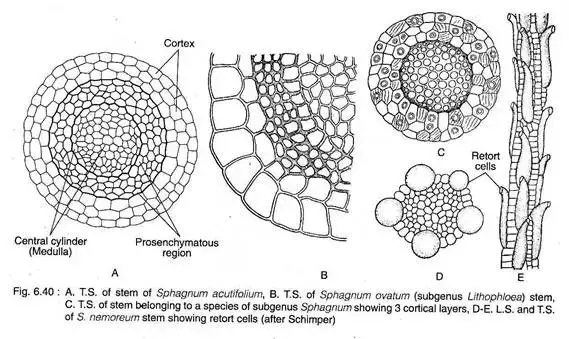
(c) Central Cylinder or Medulla
It is the smallest part in the stem composed of small, vertically elongated small-walled, parenchymatous cells. It is used as a storage zone.
Leaf
The Sphagnum cross-sectional area of the leaf is only one cell, and is comprised of extended cells. The young leaf is composed of rectangular or square cells with uniform size when a mature leaf distinguished by two kinds of cells, the regular type hyaline cell and the chlorophyllose green cells, or the assimilatory cell.
Hyaline cells are polygonal. They change into colorless or hyaline when they lose their protoplasts. The walls of their cells are adorned with pores, and they become spirally thickened. Hyaline cells possess incredible capacity of the absorption of and retention of water (hence they are referred to as capillary cells) Therefore, the rhizoids do not need to be present in mature plants.
The chlorophyllose cell is a small biconvex or triangular living cell with a number of discoid chloroplasts. They are able to produce photosynthetic energy. The hyaline as well as the chlorophyllose cells are laid out in an alternate order to create an equilateral reticulate pattern. the leaf-like appearance can be used by itself to determine the genus Sphagnum.
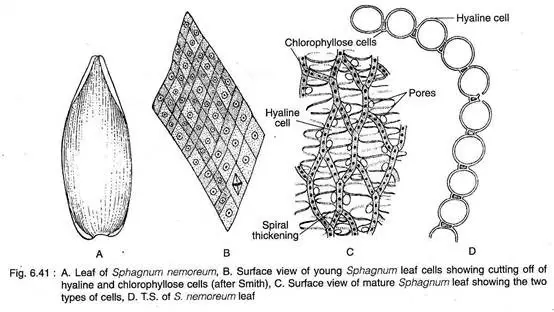
Gametophytic Phase of Sphagnum
1. External Features of Sphagnum
Plant body is gametophytic, and is composed of two phases:
Juvenile stage as well as leafy gametophore stage is known as protonema and is created by the germination of spores. It has an irregularly lobed thallus similar structure, with a single cell with a thickness of. It is connected to the substratum with multicellular rhizoids, with an the oblique septa. From the protonema emerges the erect gametophyte, also known as the gametophore.
(a) Leafy Gametophore
It’s the adult version. It is the adult form of gametophyte (gametophore) can be found in all seasons and is differentiated into axis,’stem leaves’.
Stem:
It’s erect and can be up to a foot in length and has an overall diameter of 1.2 millimeters. The stem is well-branched and the branching is generally in the lateral direction. Near the apex stem, the branches are small and do not grow much and are tightly grouped to form a large head, known as a Comal the tuft or the coma. The formation of a coma is because of the extremely short internodes near the top of the stem.
Lower on the stem, there are long branches. They usually form clusters that range from 3 to 8 (commonly five) within the axil of each 4th leaf that is on the stem. The branches can be classified into two varieties.
- Divergent branches: They grow in the lateral direction from the root, and extend upwards in a horizontal direction.
- Drooping or Flaogelliforms branches: They grow in the later part of their origins from the root. they hang, droop, or hang near to stems. These branches, whether pendent or decurrent, are water conductors.
(b) ‘Leaf’
Leaves grow along the stem and in the branches. The stems are small in distance but on branches they are interspersed. The leaves are laid out in a spiral fashion with the phyllotaxy being 2/5 i.e. the sixth leaf is higher than the first. They are small, thin fleshy, oblong, and slender with an extensive base. The margin is completely rounded with an the apex being acute.
The mid rib is missing. If you look at it from the surface, the leaf is comprised of two distinct kinds of cells: tiny living photosynthetic cells that contain chlorophyll, and larger hialine rhomboidal cell. They are characterized by tiny pores. The pores are round in form and are mostly focused on the drinking water.
The spiral thickenings are also found in cells. The thickening compensates for lack of mechanical problem. The leaves on branches are less than the stem. They are arranged in an imbricate pattern.
2. Internal Structure of Sphagnum
(a) Axis or ‘Stem’:
The transverse section of the axis is divided into three distinct zones:
- Cortex or hyaloderm
- Prosenchymatous region or hadrome
- Central cylinder or Medulla.
(i) Cortex
It is the most outer region that is located on the outside of the axis. The cells are tiny and make up a dense tissues. In the axis of young cortex, it is just 1 cell in thickness. It is in S. subsecundum, it is one layer throughout its entire existence but in most species it’s composed of multiple layers. In S. the recurvum species, S. obtusum, it is made up from two or three layers Hyaline cells.
In S. Acutifolium, S. the squarrosum comprised of between two and five cells. When it comes to S. palustre the cortical cells show spiral thickenings, as well as large oval perforations along their walls. In the branches, cortical cells remain one-cell large and thick. Cortical cells are able to store water. These cells absorb water via capillary action, and compensate in the absence of Rhizoids the gametophytic adult plant.

In certain species of Sphagnum in some species of Sphagnum, e.g., S. Molluscum, S. tenellum, certain cortical cells expand to create a long, curved structure that has a curving neck and opening. These altered cells resemble Retort, hence they are known as’retort’ cells. They are inhabited by tiny microscopic creatures. They are not present in the species that have the pores and thickenings are found in cortical cells.
(ii) Prosenchymatous region
The Cortex follows a cylindrical made of narrow and thick-walled elongated cells. It has 4-6 layers and is surrounded by the medulla. It provides mechanical support for the axis’ tissues.
(iii) Medulla or Axial Cylinder
It is comprised of thin walls, colorless cells that are parenchymatous. It is similar to the pith of higher plants and acts as a storage area.
(b) ‘Leaf’
The transverse portion (T.S.) of the leaf reveals that it’s one cell thick. In the young leaves, the cells are rectangular, and identical in size.
In mature leaves, the T.S. appears to be beaded or moniliform because of its presence in two kinds of cells, the large capillary or hyaline cells, and the smaller green assimilatory or photosynthetic cells. The two kinds of cells frequently alternate with one another. S. Acutifolium’s Hyaline cells swell towards the underside of the leaf , while the green cells form a triangular shape. The bottom of the triangle is pointed toward the upward direction.
In S. Tenellum, both kinds of cells have a reverse to this. In S. Squarrosum, these cells appear green. They are hemmed both above and below by the hyaline cells and can appear spindle-shaped the transverse section. Their ends do not touch the lower or upper edge of the leaf. They are also dead, and saturated with water, whereas assimilatory cells are alive and active in their photosynthetic the sense that they are photosynthetic.
Reproduction in Sphagnum
Sphagnum reproduces through sexual and vegetative means.
1. Vegetative Reproduction
It is accomplished by the following techniques:
(a) Innovation
It is the most common technique of reproduction. It is accomplished through the creation of particular plant-based branches, also called innovations. Sometimes, one or more branches of the axillary cluster develops strength and then grows upwards. The branch displays the same characteristics as the principal axis, and is referred to as an innovation. Every innovation is transformed into a completely new plant once you it is separated from the plant that was originally.
(b) Multiplication of Protonemal Branches:
Any cell that is marginal to the protonema’s primary cells can turn mesistematic, and form the green cellular filament. The apical part develops into a flat, like thallus-like primary protonema that is green. The secondary protonema’s margin cells make up the gametophore that is leafy.
(c) Regeneration
The development of new organs or tissues to replace those that are lost or damaged due to injuries is known as regeneration. Sphagnum is an excellent source for regeneration.
When dessication is taking place it is possible to monitor the growth of Sphagnum is controlled because metabolic processes such as photosynthesis and respiration are suspended. However, the cytoplasm exhibits the highest degree of resistant to the dessication. When there is water, the processes are restored and normal growth is observed. These plants are referred to as pallacuophytes.
2. Sexual Reproduction in Sphagnum
Sphagnum can be monoecious or dioecious. However, the archegonia and antheridia are always found on distinct archegonial and antheridial plants. The branches are significantly smaller than the branches of the vegetative. In monoecious plants the antheridial branches are first developed.
(a) Antheridial Branch
Antheridial branches initially appear at the apex main shoot, but they eventually move downwards as a result of the expansion of the apical area. They tend to be shorter , but more robust than leaves. They’re spindle-shaped and covered in yellow, red or darker green leaves. They are generally smaller than the leaves of the foliage.
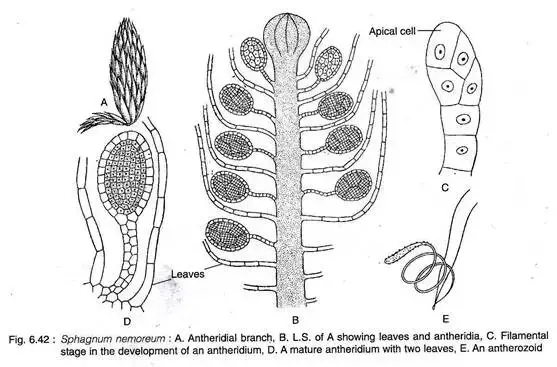
The structure and development of Antheridium: Development of Antheridium antheridia form in a single, in a cropetal manner below the leaves. Each antheridium begins as an intheridial infancy of the stem. The antheridial inception develops into small filamentous structures. Its terminal cells is enlarged through two cutting edges to create an apical cell.
The second is further differentiated into a 12–15-celled structure, where 2-5 distal cells formed by periclinal division make up The body of the antheridium, and the remaining cells make up the stalk. Each distal cell gives birth to an outer initially and an internal principal androgonial and offspring cell. The first androgonial androgenous cell, after further divisions across all possible planes, is formed into the antheridium. A single-layered outer layer is formed from the initial jacket.
The Mature Antheridium: The Mature Antheridium has an extensive stalk consisting comprising two to 4 rows of cells as well as an oblong or ovoid body. The body’s outer shell consists consisting of a single layer of cells, which is enclosed by the mass of androcytes derived from the mother cells of the sperm. Each androcyte cells transforms into an antherozoid spirally coiled or the sperm.
Dehiscence of the Antheridium: The apical cells of the outer jacket of an adult antheridium expand by transpiration of water. Due to the this pressure the block of swollen and enlarged antheridium splits into several irregular lobes near the apex. They then rotate inwards. The mass of androcytes is pushed out, and the antherozoids get released immediately and can freely swim in the water.
(b) Archegonium Branches
Five to seven archegonia grow on the tips of the shorter archegonial branches. The leaves on the archegonial branches appear green. They are larger than those of the vegetative branches. The leaves are known as perichaetium. These leaves guard the archegonia and young sporophytes. They also offer food to the sporophytes that are developing.
The archegonia that grow direct from an apical cells that is part of the branch called archegonial is known as primary archegonia, whereas the rest are referred to as secondary archegonia. An archegonium in nature is a lengthy and stalked, with a ventriloquism and a neck that contains 8 or nine neck canals as well as a venter canal cells and an egg cell.
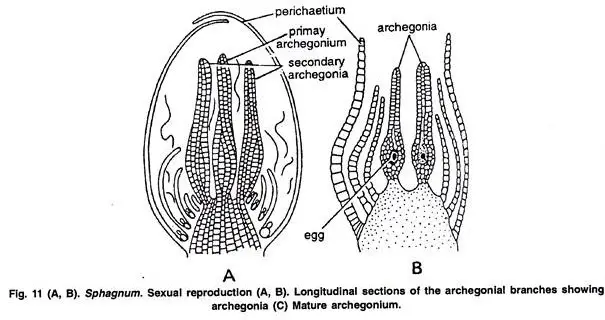
The Archegonium’s Structure and Development: The archegonia form on the apex archegonial branches in a single cell or together. The apical cells of this branch is the archegonium primary. A number of secondary archegonia are formed from cells that are derived from the apical one.
Usually you will find three archegonia that form an archegonia group i.e. the primary archegonium that is located at the apex, and two secondary archegonia arise from the base of the primary archegonium. The growth of both main and secondary archegonia is identical. The archegonial’s first division occurs transversely to make a four- or six-celled filament.
The terminal cell, with three intersecting vertical walls splits off three periclinal beginning cells and a primary an axial cell.The primary Axial cell splits transversely to create an upper cover initial and a lower central cell. The central cell is divided transversely to create an upper neck canal primary cell as well as a lower ventral primary cell.
The neck canal cell that is the primary through repeated transverse divisions forms a line consisting of between 8 and 10 neck canal cells while the primary ventral cell with only one transverse division creates a ventral canal cell along with an egg. The cover initially splits vertically to form a cluster consisting of 8 or more cells, which form the upper part of the archegonial coat.
The jacket’s initial layer, characterized with anticlinal and periclinal divisions, then creates the neck as well as the central and the basal portions that forms the archegonial coat. The cells that cover the neck form the upper part that forms the upper part of the archegonial coat.
Mature Archegonium: The mature archegonium is an extremely massive structure. It is characterized by a long stalk, a long and twisted neck, eight to nine cervical canals, an enormous multilayered ventrer that contains the ventral canal cell as well as an egg.
Fertilisation of Archegonium: The process of fertilization occurs only when there is water. Antherozoids can freely swim within the water, and then get to the archegonia. As they mature cervical canal cells as well as the ventral canal cells disintegrate and create a passageway to the antherozoids.
The antherozoids extend towards the archegonia that is attracted by chemotactic attraction and move through the passageway to get to the egg. In the end, just one antherozoid joins the egg to form an embryo.
Fertilization in Sphagnum
The fertilization process is similar with the other bryophytes. Water is the most important ingredient for fertilization.
In the process of fertilization, cervical canal cells and the ventr canal cells break down and form a clear path that allows the antherozoids. They are able to enter through the cells of the cover and extend towards the egg however, only one of them fuses with the egg and forms the Zygote. Within S. subsecundum, the ventro canal cell remains and fused together with egg cells, forming a the zygote.
The Sporophyte
The sporogonium grows from one archegonium. The other archegonium however, could also last for a while. The mature sporogonium can be distinguished into capsule and foot. Both are joined by the neck’s narrow, short like constriction, which is a symbol of the suppressed seta. The and the sporogonium is elevated upon the short, cylindrical stalk that is leafless, called the pseudopodium.
It is gametophytic. it forms by post fertilization intercalary development of the archegonial axis branch.
The pseudopodium, along with the lower portion of the calyptra creates an enveloping sac, called the vaginula that surrounds the foot. The primary purposes of the pseudopodium is to raise the capsule over the perichaetial leaves to counteract for the seta’s suppression and assist in dispersing the spores.
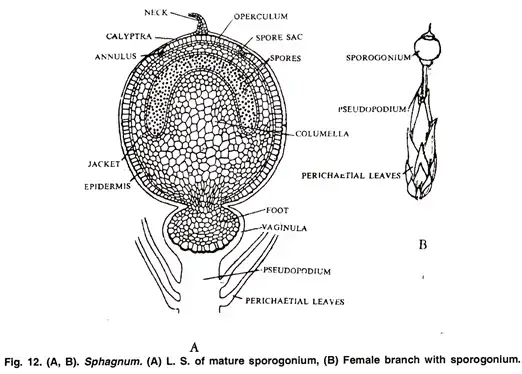
Foot:
It is bulbous and composed by parenchymatous cells. Its primary function is to absorb nutrition for the developing sporophyte.
Capsule:
It is spherical, and dark brown in color. It has a central columella that is arched over by a do-shaped spore sac, which contains the haploid spores. The capsule’s wall is 4-6 layers in thickness. The outermost layer of the capsule’s wall is known as epidermis. The epidermis cells are well-organized and contain chloroplasts.
It is home to a variety of functional and basic tomata. In the sporogonium of young age it is a convex, circular disc appears on its top. It is referred to as operculum. It is separated from remainder of the capsule by an annular (ring similar to) groove that is made up of thin walled cells, known as annulus.
Dispersal of spores or Dehiscence of capsule:
In sunny days, the columella of a mature capsule gets dry, then breaks down, and creates a huge air sac beneath an air sac. Air can enter the cavity via the stomata, which is a basic opening.
The capsule’s wall gets dry under the sun’s influence and the spherical shape of the capsule gradually turns cylindrical. The air that is imprisoned in the capsule expands and holds in significant pressure because of the change to the form and shape of the capsule.
The operculum is also dried and shrinks. This causes a slight tension difference can be created. This puts stress on the annulus’s thin cells that eventually split due to the pressure that builds up in trapped air. The operculum is then blown away by an explosive force.
The imprisoned air pressure also causes spore sacs to rupture which is then a cloud orange or yellow colored spores are blown up to an altitude of several centimeters within the air. The mechanism for releasing spores is hence, called the explosive or air gun mechanism.

Structure and Germination of Spore
Every spore is uninucteare and triangular or spherical. It is surrounded by two layers with triradiate marks. This outer layer is made of omanemted material and called exine, while the interior wall is smooth and referred to as intine. The spores are viable for a several months, and they germinate in favorable conditions. Spores absorb water and then swell to.
Exine breaks and the intine is released out as the germ tube. The germ tube splits transversely and forms 2-4 green filaments. In the terminal cells of filaments, it forms two cutting edges. It cuts the segments in alternating fashion left and right anal, forming a green one cell thick plate-like form.
The protonema is referred to as primary. The apical cells lose activity , and plates’ marginal cells such as protonema are active and form secondary protonema , which is a combination of leaves and rhizoids. These buds eventually grow into leafy gametophores.
Resemblance with Marchantiophyta (Liverworts)
The liverworts are among the most common. Sphagnum is more like the other members of the group Jungermanniopsida according to the following factors:
- The disc-shaped protonema of Sphagnum looks like the stage that is juvenile of certain lungermanniopsida (e.g., Metzge- Riopsis pusilla).
- Position and structure as well as the mechanism for dehiscence of antheridium are similar to similar to Jungermanniopsida (e.g., Porella).
- The structure, development and position of archegonia are similar to that of lungermanniopsida.
- The presence of stomata with rudimentary functions scattered throughout walls of the capsule are similar to Jungermanniopsida.
Resemblance with Anthocerotophyta (Hornworts)
The sporophyte from Sphagnum has a resemblance to Anthocerotophyta in the following characteristics:
- The absence of apical growth is evident in the sporophyte’s young.
- The archesporium development process is derived from the amphithecium
- Dome-shaped amphithecium encases arches over the columella
- The whole endothecium is transformed into columella.
- Chlorophyllose cells are present in the capsule wall
- A the bulbous foot with constriction reminiscent of seta.
Resemblance with Bryophyta (Mosses)
Sphagnum is similar to the other members in Bryophyta by the following ways:
- There is evidence of an the radial, erect, leafy gametophyte.
- The presence of multicellular rhizoids is correlated with an oblique septa.
- Development of the leaf stem, and antheridium.
- The archegonium’s shape.
- The absence of the elaters.
- Dehiscence of capsule caused by rupture of the operculum.
The difference between Peat Mosses (Sphagnum spp.) from other Mosses
In contrast to others mosses (granite moss and true mosses. ) Peat mosses have distinct characteristics like:
- Protonemata are low-structure (thallose).
- Gametophytes stems from adults free of Rhizoids.
- A few of their gametophyte branches are spreading, and some are pendent.
- A healthy plant is alive, and partially dead. The top layer is alive, while the lower portion is dead due to lack of light. It is currently in a state of decay.
- The leaves have no midrib.
- The presence of retort cells is evident within the cortices of the branches to the side.
- The stem’s cortex comprised of empty, dead cells that have large porous walls. The dead cells absorb water.
- Their leaves are characterized by a single-layered cell network with large dead photosynthesis chlorophylfose cells. Hyaline cells store and absorb water.
- The elongated portion of the sporophyte i.e seta is minimally developed, its role as stalks is assumed by the gametophyte-derived pesedopodium.
- The columella’s shape is that of an Hemisphere.
- The capsule does not have peristome teeth.
- The peat moss cells’ walls hold a significant amount of colloidal organic substances nature. Cell walls act as an Ion exchangers that absorb magnesium and calcium ions, in turn, and then release hydrogen-ion ions. They provide and maintain a less acidic environment (pH 3-4) which encourages their own growth, however, it is intolerant to everyone, except for the most specialized of other plants.
- Text Highlighting: Select any text in the post content to highlight it
- Text Annotation: Select text and add comments with annotations
- Comment Management: Edit or delete your own comments
- Highlight Management: Remove your own highlights
How to use: Simply select any text in the post content above, and you'll see annotation options. Login here or create an account to get started.